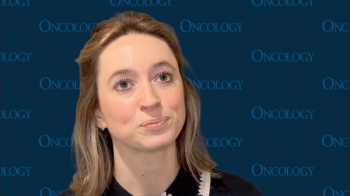
Novel Agent Active in FLT3-Positive Acute Myeloid Leukemia
Crenolanib, a type I pan FLT3 inhibitor, had activity in a group of patients with FLT3-positive acute myeloid leukemia (AML), including a number of patients with FLT3 D835 mutations.
Crenolanib, a type I pan FLT3 inhibitor, had activity in a group of patients with FLT3-positive acute myeloid leukemia (AML), including a number of patients with FLT3 D835 mutations, according to the results of a study presented at the 2016 American Society of Clinical Oncology (ASCO) Annual Meeting, held June 3–7 (abstract
“These results show that crenolanib is a drug that has clinical benefit to patients with relapsed or refractory AML with FLT3 mutations-both in patients that have ITD and tyrosine kinase domain mutations,” said Jorge E. Cortes, MD, of the University of Texas MD Anderson Cancer Center.
FLT3 is one of the most common mutations encountered in patient with AML occurring in approximately 30% of all patients. Previous research has shown that these mutations are associated with worse outcomes.
This phase II study included 69 patients with relapsed or refractory FLT3-positive AML who were treated with crenolanib 100 mg three times a day (n = 43) or 66 mg/m2 in three divided doses per day (n = 26). The trial included three cohorts of patients. Cohort 1 required that patients did not receive a prior FLT3 inhibitor (n = 19). Cohort 2 required that patients received a prior FLT3 inhibitor (n = 39). Cohort 3 was patients with secondary AML regardless of prior exposure to FLT3 inhibitors (n = 11). The primary objective was response rate as well as safety.
Of the overall study population, more than half of patients had ITD and D835 mutations, including 42% of patients who had both. This was driven mostly by patients in cohort 2 with prior TKI exposure, where 54% of patients had ITD and D835 FLT mutations.
In cohort 1, the overall response rate was 47%, with 37% of patients achieving a complete response and 11% achieving a partial response. The median overall survival was 238 days.
The researchers analyzed several parameters that could have influenced overall survival among these patients in cohort 1. First, they found that patients aged younger than 60 had longer survival than those who were 60 years or older (238 days vs 133 days). In addition, the median overall survival was 251 days among patients with two or fewer prior lines of therapies and 133 days in those with three or more. Finally, the median overall survival was 238 days in patients with ITD mutations compared with 234 days in patients with the tyrosine kinase domain mutation and 128 days in patients with both.
Cohort 2 had 39 patients who received crenolanib after having progressed on prior tyrosine kinase inhibitors. The most commonly received tyrosine kinase inhibitor was sorafenib. The overall response rate in cohort 2 was 28%, with a complete response rate of 15% and a partial response rate of 13%. The overall survival in this cohort was shorter, at 94 days.
“The survival curve was somewhat better for patients who had only ITD compared to patients with both ITD and the tyrosine kinase domain mutation,” Cortes said. “The two patients with tyrosine kinase domain alone had an overall survival of 42 and 201 days, respectively.”
Finally, cohort 3 consisted of 11 patients who developed FLT3-positive AML after prior myelodysplastic syndrome or after prior myelofibrosis, polycythemia vera, and systemic mastocytosis. Only one patient had a partial response. The overall survival in this group was only 64 days.
The most commonly occurring adverse events were nausea, vomiting, and diarrhea, which occurred in more than one-half of patients. The most commonly occurring grade 3/4 events were febrile neutropenia and pneumonia.
Newsletter
Stay up to date on recent advances in the multidisciplinary approach to cancer.

















































































